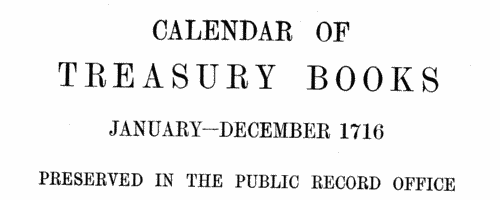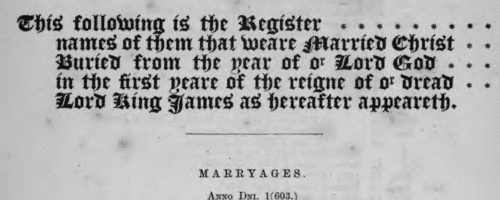Add this eBook to your basket to receive access to all 284 records. Our indexes include entries for the spelling binks. In the period you have requested, we have the following 284 records (displaying 21 to 30): These sample scans are from the original record. You will get scans of the full pages or articles where the surname you searched for has been found. Your web browser may prevent the sample windows from opening; in this case please change your browser settings to allow pop-up windows from this site. Treasury Books
(1714-1715)
Records of the Treasury administration in Britain and the colonies, for August 1714 to December 1715. This is a digest of Treasury Minute Books T29/21-22; Disposition Books T61/22-23; King's Warrants T52/24, 26-29; Order Books T60/8-9; Plantation Auditor Out Letters T64/90; Caveat Book T64/40; Warrants Relating to Money T53/14, 16-25; Warrants Not Relating to Money T54/21-24; Lord Chamberlain's Warrants T56/18; Queen Anne's Debts T56/34; Customs Out Letters T11/16; General Out Letters T27/21-23; Ireland Out Letters T14/9-10; North Britain (Scotland) Out Letters T17/2-3; Affairs of Taxes T22/2; Reference Books T4/8-9; and Register of Papers Read at the Treasury Board T4/19: prepared by William A. Shaw for the Lords Commissioners of Her Majesty's Treasury. | Sample scan, click to enlarge

| Customs Officers
(1715-1716)
Abstract of the Treasury declared accounts for the Customs: General Account, Christmas 1715 to Christmas 1716, AO 1/644/246; Cash Account, Christmas 1715 to Midsummer 1716, AO 1/786/985; Tobacco, General Account, Christmas 1715 to Christmas 1716, AO 1/645/249, and Cash Account, Midsummer to Christmas 1716, AO 1/787/993; Wines and Vinegar, General Account, Christmas 1715 to Christmas 1716, AO 1/645/248, and Cash Account, Christmas 1715 to Midsummer 1716, AO 1/786/987; Silks and Linens, General Account, Christmas 1715 to Christmas 1716, AO 1/645/247, and Cash Account, Christmas 1715 to Midsummer 1716, AO 1/786/986. Most, but not all, of the names which appear in these accounts are those of the customs officers at London and the outports throughout the kingdom. | Sample scan, click to enlarge

| Treasury Books
(1716)
Records of the Treasury administration in Britain, America and the colonies, for 1716. These also include records of the appointment and replacement of customs officers such as tide waiters and surveyors. | Sample scan, click to enlarge

| Treasury Books
(1717)
Records of the Treasury administration in Britain, America and the colonies, for 1717. These also include records of the appointment and replacement of customs officers such as tide waiters and surveyors. | Sample scan, click to enlarge

|  Masters and Apprentices
(1719) Masters and Apprentices
(1719)
Apprenticeship indentures and clerks' articles were subject to a 6d or 12d per pound stamp duty: the registers of the payments usually give the master's trade, address, and occupation, and the apprentice's father's name and address, as well as details of the date and length of the apprenticeship. 1 January to 20 June 1719. | Sample scan, click to enlarge

|  Masters and Apprentices
(1720) Masters and Apprentices
(1720)
Apprenticeship indentures and clerks' articles were subject to a 6d or 12d per pound stamp duty: the registers of the payments usually give the master's trade, address, and occupation, and the apprentice's father's name and address, as well as details of the date and length of the apprenticeship. 5 September to 31 December 1720. | Sample scan, click to enlarge

| Citizens of London: Bakers
(1724)
A list of the persons who polled for Charles Goodfellow esquire at the late election for a member of parliament to represent the city of London, held 23rd to 28th November 1724. Full names are given, surname first, arranged by the livery companies to which the citizens belonged. This list was published in The Daily Post and elsewhere: 'Gentlemen, we desire you will carefully examine the following list of polsters, and in case you find yourselves or friends polled by others, or any polled who are dead or absent, or who have no right, that you'll give immediate notice thereof at Salter's Hall in Swithin's Lane, where attendance will be daily given from 8 a-clock in the morning till 9 a-clock at night. It is not doubted but the endeavours to obtain a law to secure your invaded rights and privileges will be soon successful, this should now excite you to a diligent search after false pollers, which will in all probability make the majority greater for sir Richard Hopkins. N.B. The scrutineers so far as they have proceeded, do find a much greater number of false pollers for Mr Goodfellow, than for sir Richard Hopkins.' | Sample scan, click to enlarge

|  Masters and Apprentices
(1727) Masters and Apprentices
(1727)
Apprenticeship indentures and clerks' articles were subject to a 6d or 12d per pound stamp duty: the registers of the payments usually give the master's trade, address, and occupation, and the apprentice's father's name and address, as well as details of the date and length of the apprenticeship. 2 January to 4 March 1727 | Sample scan, click to enlarge

|  Masters of Apprentices registered at York
(1728-1731) Masters of Apprentices registered at York
(1728-1731)
Apprenticeship indentures and clerks' articles were subject to a 6d or 12d per pound stamp duty: the registers of the payments usually give the master's trade, address, and occupation, and the apprentice's father's name and address, as well as details of the date and length of the apprenticeship. There are central registers for collections of the stamp duty in London, as well as returns from collectors in the provinces. These collectors generally received duty just from their own county, but sometimes from further afield. (The sample entry shown on this scan is taken from a Norfolk return) | Sample scan, click to enlarge

| Wandsworth Burials
(1733)
The ancient parish of Wandsworth in Surrey comprised the single township of Wandsworth, including the hamlets of Garratt, Half Farthing and Summers Town. It lay in the archdeaconry of Surrey of the diocese of Winchester: unfortunately, few bishop's transcripts of Surrey parish registers survive earlier than 1800. Although the original parish registers of Wandsworth doubtless commenced in 1538, the volume(s) before 1603 had been lost by the 19th century. In 1889 a careful transcript by John Traviss Squire of the first three surviving registers was printed, and we have now indexed it year by year. The early burial registers contain little detail - date of burial, and full name. For the burial of children, the father's name is also stated; for the burial of wives, the husband's. Such details as date or cause of death, age, address or occupation are almost never given. The burial registers are considerably more bulky than the baptism registers, because the burying ground was used by Dissenters, who formed a large part of the population. These include a French Protestant congregation that worshipped in a church (the registers of which do not survive) in a courtyard immediately opposite the parish church. The Quakers had a cemetery of their own. The 18th-century burial registers also include a surprising number of children sent out to Wandsworth from London to nurse. | Sample scan, click to enlarge

|
Research your ancestry, family history, genealogy and one-name study by direct access to original records and archives indexed by surname.
|












